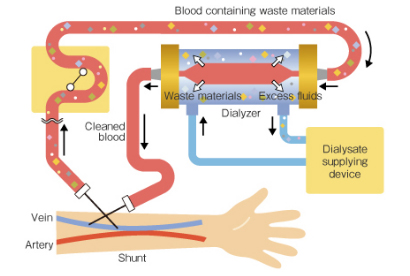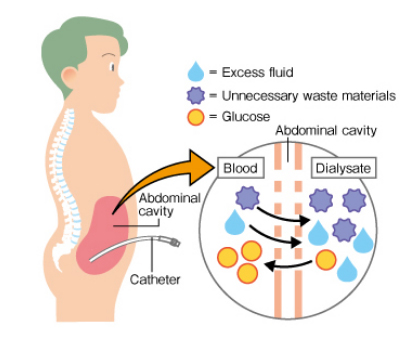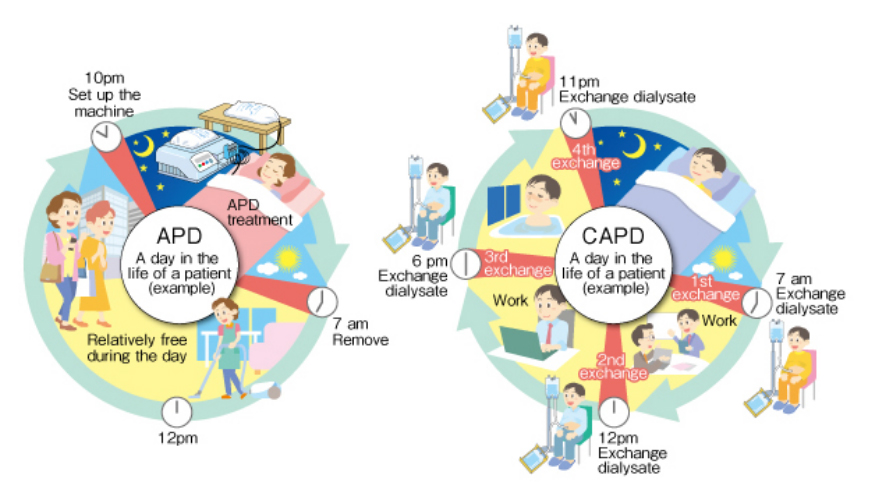- HOME
- Medical Departments
- Nephrology
- About Renal Replacement Therapy
Medical Departments
Nephrology
- About Renal Replacement Therapy
- Hemodialysis and Peritoneal Dialysis
- About Hemodialysis (HD)
- About Peritoneal Dialysis (PD)
- Aiming for a Support System that Make PeritonealDialysis (PD) a Possible Option
- Kidney Transplant Therapy
About Renal Replacement Therapy
When chronic kidney failure is exacerbated and kidney function falls to between 10% and 15% of normal kidney function, renal replacement therapy (therapy that replaces the function of the kidneys) such as dialysis or transplant is required.
We make an effort to work in consultation with patients and their families to select a treatment method in line with the patient’s wishes and condition.
Hemodialysis and Peritoneal Dialysis
Dialysis therapy consists of hemodialysis (HD) and peritoneal dialysis (PD).
Hemodialysis (HD)・・・
Dialysis that is conducted three times per week at a medical facility by specialized staff.
One treatment session takes approximately four hours. When preparation time prior to treatment and time spent stopping the blood flow and for meals is included, it takes five to six hours.
Peritoneal Dialysis (PD)・・・
An in-home therapy conducted as a part of daily life in the workplace or at home.
There is CAPD, where the patient exchanges the bag themselves several times per day, and APD, which is conducted automatically by a machine while the patient is sleeping.
The difference between hemodialysis (HD) and peritoneal dialysis (PD)
| Hemodialysis (HD) | Peritoneal Dialysis (PD) | |
|---|---|---|
| Surgery |
Surgery to create shunt Approximately one hour under local anesthesia / out-patient surgery |
Surgery to insert Tenckhoff catheter Approximately one hour under general anesthesia |
| Treatment Method | Intermittent / three times per week at a hospital / four hours per treatment | Continuous / daily |
| Dialysis Efficiency | Good | Slow and gradual |
| Stress on the Heart | May be considerable in some cases | Minor |
| Dietary Restrictions | Very restricted | Loosely restricted |
| Status when first introduced | Fluctuations in blood pressure / headaches / nausea | Pressure in the abdomen / mastery of skills |
| Bathing | Only on days with no dialysis | Daily |
| Disadvantages |
Pain from inserting needles Strict dietary restrictions Considerable stress on the heart Infection of the shunt / issues |
Need to clean the opening daily Risk of developing peritonitis Need to switch to HD after 5 to 7 years on average |
| Advantages |
Just need to go to the hospital Can leave it up to the hospital staff Seen by medical professionals three times per week |
Suitable for returning to work and society Loose dietary restrictions Good in the event of a natural disaster |
| Freedom of Movement | Free on days with no dialysis | Free to move even during dialysis |
About Hemodialysis (HD)
A treatment where a continuous process is conducted in which blood is drawn out of the body using a dialysis machine, and the blood is run through a dialyzer, which is a manmade kidney. Waste materials are removed and the blood is cleaned before returning the blood to the body.

In order to continue this treatment, patients go to a dialysis facility three times per week.
Four to five hours are required per dialysis treatment. Healthy kidneys work full time 24 hours per day, but time and efficiency are limited with hemodialysis, and it cannot fully replace the function of healthy kidneys.
As a result, changes must be made in aspects of daily life such as meals and exercise.
| Mon | Tues | Wed | Thurs | Fri | Sat | Sun |
|---|---|---|---|---|---|---|
| ● | ● | ● | ● | ● | ● |
●=Hospital treatment days for patient A ●=Hospital treatment days for patient B
※In principle, patients will undergo dialysis throughout their lives including holidays and New Year’s.
About Peritoneal Dialysis (PD)
Dialysate is first injected into the abdomen and left for a certain period of time to remove toxins from the blood. With CAPD, the dialysate in the abdomen is exchanged three to four times per day.
With APD, peritoneal dialysis is conducted automatically while the patient is sleeping by connecting a machine at night.
One exchange with CAPD takes approximately 30 minutes. One APD session takes approximately six to ten hours.
As time can be used flexibly, it is suitable for patients who are working or otherwise wish to return to society.

Living with PD

Aiming for a Support System that Make PeritonealDialysis (PD) a Possible Option
Peritoneal dialysis (PD) is a method of dialysis that is basically conducted at home or while out by the patient themselves or by a family member. Once the correct operation of the equipment is mastered, the patient need only come to the hospital one to two times per month, and there is no pain from insertion of a needle, no need for the patient to be lying down in bed during dialysis, and less fatigue and lethargy after dialysis, making it a method of dialysis that is less physically demanding. However, ensuring that the patient or a family member could correctly operate the equipment had been the criteria for adopting this method.
As the age for introducing dialysis has risen, there have been patients who have been unable to select peritoneal dialysis as an option due to issues with operating the equipment and catheter management. We at the Kaikoukai Healthcare Group have made a pioneering effort in Japan and worked to create a system within the group to support patients like these in thinking of the “less physically demanding” peritoneal dialysis as an option. Through a process of trial and error, we continue to take on the challenge of creating a system that will enable as many elderly patients who require dialysis as possible to think of peritoneal dialysis as an option.
Kidney Transplant Therapy
At Nagoya Kyoritsu Hospital, we also handle kidney transplant consultations in collaboration with the Organ Transplant Department of Fujita Health University Hospital.
【Cardiovascular Medicine】
052-362-5151052-353-9105
Kaikoukai Healthcare Corporation,Nagoya Kyoritsu Hospital
1-172 Hokke, Nakagawa-ku, Nagoya-shi, Aichi454-0933, JAPAN